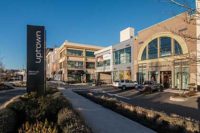
The Monterey Bay Aquarium recently replaced the vast liner of its million gallon tank with a ¼-inch thick, deep blue shell made of fiber reinforced polymer (FRP) composite. It creates the effect of looking into the depth of the open sea, habitat of some of the aquarium’s largest animals. The liner’s 180 panels were designed, fabricated and installed by Kreysler & Assocs. Here, all the panels had been installed, and were ready for final finishing.
The Monterey Bay Aquarium in Monterey, Calif., recently replaced the vast tank-liner in its million-gallon Open Sea exhibit. The 80-foot-long eggshell of 1/4-inch-thick Fiber Reinforced Polymer is the “scenic backdrop” of the tank, designed to create the effect of looking into the featureless depths of the sea.
“This is one of the major attractions of the Monterey Bay Aquarium,” explains Marty Manson, the aquarium’s project director. “It exhibits animals from the open ocean. The concept is that you’re looking into their habitat: the deep blue depth, open water.” It is the environment for some of the largest, most charismatic, animals in the aquarium.
The original liner, dating from the opening of the exhibit in 1996, had suffered damage due to animal behaviors that were unexpected when it was designed. The effects of turbulence created by animals swimming at high speed during feeding made the liner flex, which loosened the grout holding thousands of small blue glass tiles onto the liner surface. Many tiles became dislodged over time. That, combined with occasional impacts from large, fast-swimming tunas, made for an unsightly surface.

Creating Endless Ocean
Installation of a new liner with minimal downtime for the exhibit called for an innovative solution: fabricate it off-site and only drain the tank once the liner is ready to install.
The Aquarium brought in Kreysler & Associates (K&A), a design consultant and fabricator of composites for architectural uses. The firm used a combination of cutting-edge technology and innovative thinking to meet the goals.

Recently, K&A was able to find a special gelcoat material well suited to the problem. IMEDGE, made by Cook Composites and Polymers Company (CCP), is an enhanced in-mold coating designed to be “blush resistant” when exposed to long term water contact. It is a very hard and abrasion-resistant product, maintaining a rich clarity inherent in the color over a long period of time.

Swing-stage scaffolding like this was used to install the new FRP panels on the existing rib structure.
Another challenge was to give the 1/4-inch thick liner enough strength and impact-resistance to handle a 250-pound tuna traveling at 25 knots. This goal was achieved through the engineering of the FRP material itself. “This is a highly versatile material,” observes Bill Kreysler, president of K&A, “not only in terms of appearance, but also as a structural component. Once the tuna problem was identified and the impact forces were known, we could design for it.”
However, K&A had to design and fabricate the liner without emptying the tank to measure the installation, since the “job site” was still occupied by a million gallons of water and a host of animal residents. The plan called for re-using the original support structure, but K&A did not have direct access to its exact dimensions and curvature. The original, documented dimensions of the support ribs could not be relied upon either, because 16 years under heavy load would have predictably caused them to sag and reshape.
Under these conditions, measurement of the existing structure was limited to educated guesses that could be made from the top surface of the tank. Using that sketchy information as a starting point, K&A created a 3-D computer model of the curved surface, roughly an eggshell with part of its top and front side sliced off.
The great curved surface had to be assembled onsite from 180 pre-molded sections. Each section had to be molded separately, most with unique curvatures. To allow for differences between their guesses and the actual structure, K&A designed generous overlaps between the sections that would allow them to adjust the actual size once the tank was emptied for installation.
Many of the sections were on the order of 10 feet by 12 feet. They were shaped on molds made of large blocks of expanded polystyrene foam. The EPS foam itself was shaped by a gantry-mounted computer numerically controlled milling machine that used the 3-D computer model as a guide to nibble down the EPS to precise curves. Sheets of FRP were molded over a period of three months.
These materials and fabrication techniques can be applied to virtually any shape that can be defined in a computer model. CNC milling can create molds for uniquely-shaped large (or small) architectural elements, which can be fabricated using materials and finishes appropriate to the application. And, as the Aquarium project proves, FRP materials can be engineered to perform even under difficult conditions. This technique can produce accurate realizations of shapes and surfaces that previously existed only in a computer. The combination of digital models and CNC fabrication is, in effect, a direct link between a designer’s imagination and the physical world.

Into the Deep
When all the pieces were ready, panels were transported to the site, the tank was emptied, and the animals sent to board elsewhere. Building scaffolding in the tank to support the installers was not an option because there was no place for it to stand: the bottom of the shell’s curve covered the floor. The panels were installed using swing-stage scaffolding hanging from service slab above. During the final finish work, however, the installers stood on a floating work platform that rose as the tank was filled.The Aquarium used this exhibit’s downtime to do other renovation, including a major revision of the life support system in that wing of the Aquarium. The new set-up separates the water in the large tank from other, smaller tanks. This makes it possible to keep a warmer temperature in the Open Sea tank than in the smaller tanks of local schooling fish. It will allow greater flexibility for the Open Sea exhibition to display animals that prefer warmer-than-local water.
After 4 months of installation, the liner was completed. Following weeks of refilling and reconditioning the water, the animals were slowly introduced back into the exhibit, which was ready to reopen for the July Fourth weekend, 2011.
“Like many of our projects, this was a one-off,” points out Manson. “Technology, engineering and new materials all made it possible; what made it happen was a lot of very hard work by a smart and dedicated fabrication/installation crew and on-site team. We expect it to last a long, long time.”



